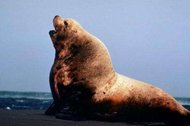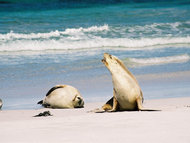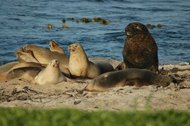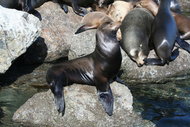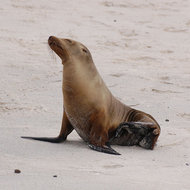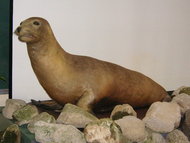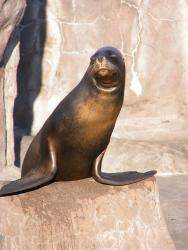Sea lions
Sea lions are seven species of marine mammals within the family of eared seals (a family of sixteen species which include sea lions and fur seals and, together with true seals and walruses, form the group of marine mammals known as Pinnipeds.)
Contents
Physical Appearance
Sea lionsdiffer from the true seals in having small external earflaps and hind flippers that can be turned to face forwards. Together with strong front flippers, this gives them extra mobility on land and an adult sea lion can move extremely fast acrossa beach if it has to. They also use their front flippers for swimming, whereas true seals use their hind flippers.
|
Scientific Classification Kingdom: Anamalia (Animals) |
Like other Eared seals, the males are considerably larger than the female, in some instances, up to five times as large. This makes them among the most sexually dimorphous mammals.
Sea lions differ from fur seal in that theyhave coarse, short fur in contrast to adense underfur characteristic of fur seal. Sea lions are also generallylarger thanfur seals.
Species
The seven species of sea lionsare grouped in five genera:
- Eumetopias1. Steller sea lion (also Northern sea lion, Sea king, Stellar sea lion, and Steller's sea lion) (Eumetopias jubatus)
- Neophoca2. Australian sea lion (also White-capped sea lion) (Neophoca cinerea)
- Otaria3. South American sea lion (also Southern Sea Lion,Patagonian Sea Lion, andManed sea lion.(Otaria flavescens)
- Phocarctos4. New Zealand sea lion (Phocarctos hookeri)
- Zalophus5. California sea lion (Zalophus californianus)6. Japanese sea lion (Zalophus japonicus)7. Galapagos sea lion (Zalophus wollebaeki)
Some species of sea lions, particularly California sea lions, are intelligent,docile and trainable and frequently used to educational purposes in zoos and aquariums, and for entertainment in marine parks and circuses. Other species, like the Steller Sea Lion, are quite antisocial and can be aggressive.
Reproduction
Sea lionsare polygynous, meaning that males will establish territories (often created and protected through fighting or shows of aggression) within which they establish a harem and breed with a number of females (the range varies with species). Males will come ashore and establish their territories at the beginning of the mating season.
Females typically arrice a few weeks after the males and select their mates for the coming season. Before mating, the females will first give birth to a pup conceived during the mating season of the prior year. Mating occursshortly after the birth of the pup.
Distribution
|
North Pacific coasts from the Sea of Japanto California | |
| Islands offshore of western/southern Australia | |
| South American coast from Rio de Janeiroon the Atlanticside and coastal Perú on the Pacific coast | |
| New Zealand's subantarctic islands, in particular Dundas Island in the Auckland Islands | |
|
Pacific coast of North Americafrom British Columbia, Canada south to Baja, Mexico | |
| formerly northwest Pacific,along the coasts of Japan, the Korean peninsula, andSakhalin Island | |
| Galapagos Islands |
Conservation Status
Sea lions have been significantly impacted by human activities. The populations of only two of the seven speciesare considered to be doing well. Three species (Steller Sea Lion, Australian sea lion andGalápagos sea lion)are endangered and one (Japanese sea lion) is believed to have become extinct in the 1950s.
| Endangered | |
| Endangered | |
| Least Concern | |
| Vulnerable | |
| Least Concern | |
| Extinct | |
| Endangered |
Further Reading
- Zalophus japonicus Aurioles, D. & Trillmich, F., 2008, IUCN (accessed April 8, 2009)
- wollebaeki Sivertsen, 1953 Encyclopedia of Life (accessed April 8, 2009)
- Zalophus californianus (Lesson, 1828) Encyclopedia of Life (accessed April 8, 2009)
- Zalophus, Seal Conservation Society (accessed April 8, 2009)
- [1], MarineBio.org (accessed, April 8, 2009)
- Galápagos and Californian sea lions are separate species: Genetic analysis of the genus Zalophus and its implications for conservation management, Wolf, JB; Tautz, D; Trillmich, F, Frontiers in zoology,2007.
- Archaeology and holocene sand dune stratigraphy on Chatham Island, B. G. McFadgen, Journal of the Royal Society of New Zealand,1994.
- The Pinnipeds: Seals, Sea Lions, and Walruses, Marianne Riedman, University of California Press, 1991 ISBN: 0520064984
- Encyclopedia of Marine Mammals, Bernd Wursig, Academic Press, 2002 ISBN: 0125513402
- Marine Mammal Research: Conservation beyond Crisis, edited by John E. Reynolds III, William F. Perrin, Randall R. Reeves, Suzanne Montgomery and Timothy J. Ragen, Johns Hopkins University Press, 2005 ISBN: 0801882559
- Walker's Mammals of the World, Ronald M. Nowak, Johns Hopkins University Press, 1999 ISBN: 0801857899
